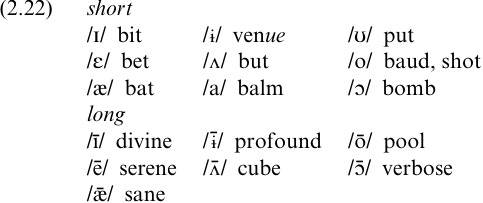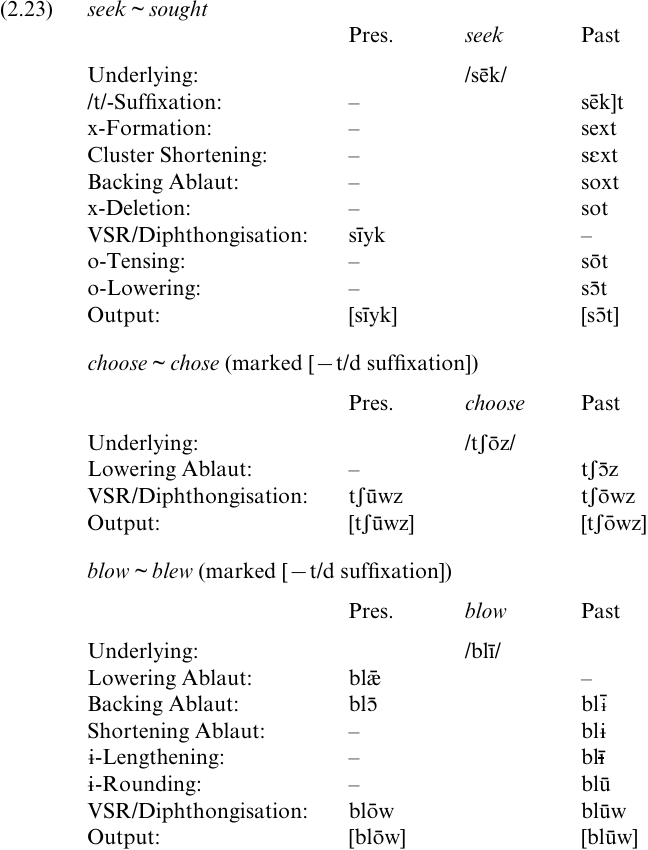


 Grammar
Grammar
 Tenses
Tenses
 Present
Present
 Past
Past
 Future
Future
 Parts Of Speech
Parts Of Speech
 Nouns
Nouns
 Verbs
Verbs
 Adverbs
Adverbs
 Adjectives
Adjectives
 Pronouns
Pronouns
 Pre Position
Pre Position
 Preposition by function
Preposition by function 
 Preposition by construction
Preposition by construction
 Conjunctions
Conjunctions
 Interjections
Interjections
 Grammar Rules
Grammar Rules
 Linguistics
Linguistics
 Semantics
Semantics
 Pragmatics
Pragmatics
 Reading Comprehension
Reading Comprehension|
Read More
Date: 2024-06-12
Date: 14-3-2022
Date: 2024-04-29
|
The most extensive and comprehensive lexicalist account of English vowel phonology currently available is Halle and Mohanan (1985), and my attempts below to constrain the framework and mechanisms of LP will focus on this version of the theory. The critique developed here is applicable also to Mohanan (1986), which shares many of the assumptions of Halle and Mohanan (1985). Although Halle and Mohanan are working within the letter of LP, their analyses frequently fail to cohere with the spirit of the lexicalist enterprise, if we take that spirit to include the reduction of abstractness and the removal of unwarranted machinery and unmotivated derivation. I shall return in detail to the Halle and Mohanan model, considering many of their analyses in depth. For the moment, I intend only to demonstrate that their model cannot be seen as a significant advance over SGP.
First, let us turn to the general architecture of the model. As noted above, the Halle and Mohanan model comprises four lexical strata, as against Kiparsky's (1982) three and Booij and Rubach's (1987) two, as well as one postlexical level. If the number of levels proposed for a language is in principle unbounded, the theory loses any claim to explanatory adequacy, since an analysis would be possible in which each word-formation rule or phonological process were assigned to a separate stratum, or every rule to every stratum. Moreover, allowing random interspersal of cyclic and non-cyclic strata, as Halle and Mohanan also do, further compromises LP in that the operation or suspension of constraints will be purely a matter of stipulation. Nor do they strictly adhere to the four lexical strata they declare; their model also incorporates a so-called Loop, which allows compounded forms derived on their Level 3 to cycle back into Level 2 affixation. Since there is no principled limit to the levels between which loops could be proposed, the way would in principle be open for such morphological interaction between every pair of strata. In Halle and Mohanan's model, the concept of morphological level-ordering is effectively dead in the water.
There are similar problems of permissiveness in their specific phonological analyses. Halle and Mohanan are primarily concerned with General American, although they claim the underlying vowel system they propose (see (2.22)) is also appropriate for RP; this assignment of a single underlying phonological system to related dialects was a characteristic of SGP which Halle and Mohanan carry over into LP.

If we were looking for a predominantly surface-true vowel system, we would not find it here. The SPE account of Vowel Shift is retained, with the tense vowels shifting in sane, serene, divine, and free rides in parallel non-alternating plain, mean, pine. A single underlying representation is proposed for the vowel in balm, and one for bomb, although the realizations vary widely across British and American accents, and indeed the two are homophonous for many speakers. Absolute neutralization is rife, with [jū] in cube and [jū] in venue derived from distinct underlying vowels.
For the moment, I consider only one further example: the Modern English strong verbs. On the principle of `can do, will do' familiar from SPE, Halle and Mohanan elect to derive alternating pairs like seek ~ sought, choose ~ chose and blow ~ blew from single underlying forms. This requires, of course, the whole panoply of SGP derivational techniques, as illustrated in (2.23).

Connoisseurs of untrammelled generative analysis will find all their old favorite tricks here. We have non-surface-true underliers; special diacritic marking; a whole complex of ablaut and related rules which are required only for these strong verbs, and yet are presented as if equivalent to productive processes; abuses of extrinsic ordering involving `lay-by' procedures; and `Duke-of-York' derivations, which involve the production, destruction and re-derivation of the desired output, as in chose.
In the face of examples like these (and there are plenty to choose from), it must be clear that LP is in serious danger of losing sight of its founding aims. Lexical Phonologists are not, of course, alone in their weaknesses here; there is a recurring tendency in phonology to invent constraints or conditions, then see these as some panacea which means entirely unrestrained derivation is somehow all right. Take Brand X, drink anything you like, and you won't have a hangover. Except that 10-to-1 you still will, and Brand X will have wreaked its own havoc on your system in the meantime. And you still behaved like an idiot.
It should go without saying, but doesn't, that constraints are useless unless they are imposed and taken seriously. There is no point in formulating restrictions if we then devote all our intellectual energies to finding ways to defuse and disarm them; as we shall see, the use of underspecification to get round SP, and the ordering of rules on Level 2 to evade SCC are excellent examples of precisely this strategy. Identifying circumstances in which the constraints fail does not occasion congratulations. At best, it is a signal that we must find the underlying principle or factor which explains the non-application of the constraint. We shall see that such explanations may in fact be historical rather than synchronic.
|
|
|
|
"عادة ليلية" قد تكون المفتاح للوقاية من الخرف
|
|
|
|
|
|
|
ممتص الصدمات: طريقة عمله وأهميته وأبرز علامات تلفه
|
|
|
|
|
|
|
المجمع العلمي للقرآن الكريم يقيم جلسة حوارية لطلبة جامعة الكوفة
|
|
|